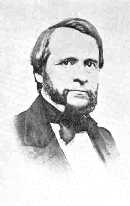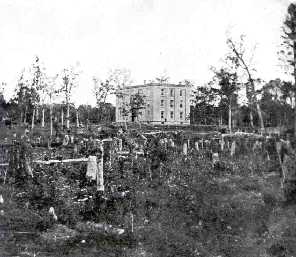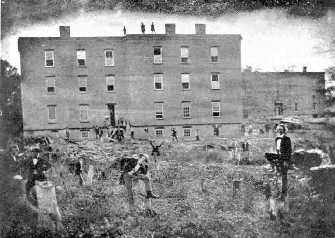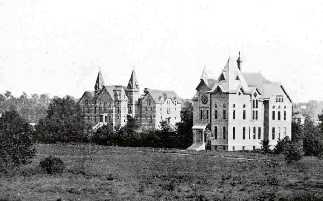 |
Michigan Agricultural College
Past and Present
By
Addison Makepeace Brown
Published in the 1916 Wolverine Yearbook
|
The Michigan Agriculture College, one of the leading units in the educational system of Michigan, had its inception in the early discussion of a general system of education for the then territory. In bringing about this discussion and in crystalizing it into definite form, the state was most fortunate in having two wise, scholarly and far-seeing men, who left the permanent impress of their wisdom and foresight upon the most important of its functions - provision for public education. A debt of gratitude is due from the people of Michigan and of the country at large, to Isaac E. Crary, member of the constitutional convention of 1835, and John D. Pierce, the first superintendent of pubic instruction in this state, and indeed in the nation, for laying the foundations of the Michigan public school system, the first thoroughly comprehensive system of education to be adopted by any state. In the first constitution it was made the duty of the legislature to encourage the promotion of intellectual, scientific and agricultural improvement, and in the act approved March 18, 1837, establishing the University of Michigan, specific provision was made for instruction in "practical farming and agriculture." So far as agriculture was concerned, however, these early efforts were not destined to eventuate into anything of permanent value for a number of years, and the final establishment of agricultural teaching in the state came about through agitation from quite a different source. There had been early established (1849), and still exists, a quasi-official organization, known as the State Agricultural Society which at once interested itself in furthering the interests of agriculture. As a natural consequence, it began to urge the importance of scientific agricultural training for those who were to engage in farming, and numerous public addresses were made by its members and others insisting upon the establishment of an agricultural school. At a meeting of the executive committee of the State Agricultural Society held in December, 1849, Hon. Bela Hubbard of Detroit, offered the following resolution which, however, was laid upon the table for reasons not easily understood: "RESOLVED, - That our legislature be requested to take such legislation as shall appear necessary or expedient for the establishment of a state central agricultural office, with which shall be connected a museum of agricultural products and implements and an agricultural library, and as soon as practicable, an agricultural college and a model farm." In January, 1850, at the request of the executive committee of the State Agricultural Society, Joseph R. Williams, who later became the first president of M.A.C., presented to the legislature "a memorial for a State Agricultural College in Michigan" which should be a branch of the State University. This memorial, for the first time, put up to the legislature the question of establishing the first agricultural college in this country and undoubtedly had its influence with the constitutional convention of 1850, for Section 11of Act 13 of that document made the following provision: "The legislature shall encourage the promotion of intellectual, agricultural and scientific improvement; and shall, as soon as practicable, provide for the establishment of an agricultural school. The legislature may appropriate twenty-two sections of salt springs land now unappropriated, or the money arising from the sale of the same, where such lands have already been sold, and any land which may hereafter be granted or appropriated for such purpose, for the support and maintenance of such school and may make the same a branch of the University, for instruction in agriculture and the natural sciences connected therewith, and place same under the supervision of the regents of the University." |
 |
Joseph R. Williams
First President 1857
|
With the agitation for an agricultural school, a three-sided discussion sprang up as to its location and management and this continued for some twelve years after the College had been opened. The State Normal School was to be opened in October, 1852, and the law provided "for instruction in the mechanic arts, the arts of husbandry and in agricultural chemistry." In view of this, on September 21st of that year, Francis W. Shearman, superintendent of public instruction, wrote to J.C. Holmes, secretary of the state Agricultural Society, calling his attention to the provisions of the Normal School act in relation to agriculture, and apparently soliciting the co-operation and support of the Agricultural Society in building up an agricultural department at Ypsilanti. A little later in the same year, Dr. Henry P. Tappan, chancellor of the University of Michigan, wrote to Mr. Holmes, informing him that in anticipation of legislation carrying out the provisions of that section of the constitution above quoted, the University had organized an agricultural school as part of the scientific course recently established. It was clear that the University did not intend to let the opportunity for mothering such a school slip. The State Agricultural Society at first seemed favorable to a plan for making the school a branch of the Normal School or of the University, but the resolution addressed to the legislature while requesting that the school be made a branch of the University contains this significant language, viz: that "the contemplated school and farm should not be established in immediate proximity to any existing educational institution." The legislature of 1853 did nothing about the matter, so it remained for the legislature of 1855 to pass the act necessary to establish the long talked of agricultural school. Previous to this, the Agricultural Society had reached the conclusion that such a school should be entirely separate from any other institution and it laid its views before the members of the legislature effectively, as the result provided. The law provided that the school and farm should be located within ten miles of Lansing and that there should be secured not less than five hundred nor more than a thousand acres of land, and to the executive committee of the Agricultural Society was committed the selection of the site. The supervision of the school was intrusted to the State Board of Education. Such was the struggle to establish the first state agricultural school in America and to fix its location. As already stated, the question of its permanent abode was a mooted one for many years after, and even at the present time one hears an occasional murmur from some visionary propagandist touching this matter. |
 |
College Hall in 1857
The First Building Erected in the United States for Agricultural Education
|
The committee named to select the site performed its function, a portion
of the salt springs land was sold and with the proceeds three buildings were
erected, College Hall, the dormitory and boarding house known as "Saints
Rest," and a brick barn now used as a carpenters shop. On May 13, 1857, the
school was formally dedicated and opened with an attendance of sixty-one
students.
Joseph R. Williams was elected its first president and delivered a very forceful and scholarly inaugural address, but, unable to hear the criticisms and discouragements inseparable from such an enterprise, he resigned in the spring of 1859, after but two years of service.During the interregnum, from 1859 to December, 1862, Louis R. Fisk was acting president, and following him came the presidency of Dr. T.C. Abbot, whose twenty-two years service had a marked effect upon the character and development of the institution. |
 |
Saints' Rest in 1857
The First Dormitory
|
In a paper of this kind, it is manifestly impossible to follow this new child of the state through all the vicissitudes that accompanied its evolution into what it is now. Located three and a half miles from the city of Lansing, with a long stretch of road between tat was at certain seasons well nigh impassible; with no means of communication except by foot passage or horse-drawn vehicle; with a forest to subdue before any progress could be made toward the real end in view; and surrounded by a carping, unsympathetic public, it need not be wondered that this institution came but slowly "into the sunlight." If mistakes were made, as was inevitable, the College was scoffed at; if new truths were discovered that should favorably affect agriculture, the farmers distrusted them and regarded them as the useless fruit of book farming. So the long years of President Abbot's administration wore away, as the institution was slowly adapting itself to its task, growing a little stronger all the time, coming into a better understanding of the farm problem and of the farmer himself. Following Dr. Abbot in the presidency came successively, Edwin Willits, Oscar Clute and Lewis G. Gorton, the administration of all three extending only from July, 1885, to february, 1896. At the time of the advent of Jonathan L. Snyder, as president on the latter date, the student attendance was 356, or 13 less than it had been six years earlier, and there were evidences of mal-nutrition in the institution which was still isolated from the outside world as in its earlier days. The total amount of funds available for that year was $109,473.39, only $16,000.00 of which were granted by the state. With an energy and perseverance that has characterized his whole administration, President Snyder set to work at once to quicken the pulse of the institution, and to breathe new life into its somewhat lethargic body. There was a quick response to his efforts in the growth of student attendance which has steadily continued down to the present time. |
 |
The First Botanical laboratory and Wells Hall
at the left, as they were in the "Good Old days."
|
President Snyder saw the opportunity that opened before the College and spared
no effort to prepare it to meet those obligations that were being rapidly
thrust upon it. Lack of funds to provide for necessary growth and development
has always been a handicap, and during the twenty years in which President
Snyder has presided over the destinies of the College, there have never been
a time when its needs were adequately met. The material growth of the institution
has largely taken place since 1900 when the Women's Hall was erected, together
with the old Dairy building, now set over to the Forestry department, and
the Dairy barn. Since then have come successively, the Power plant and tunnels,
the water system, the Bath house, the new Wells Hall, the Engineering building,
Agricultural building, additions to the Chemical and Botanical laboratories,
the new Dairy building and the Veterinary laboratory. During the period under
consideration, student attendance has gone from 156 to 2,010, and a new city
has grown up at the College, connected by interurban line with the Capital
City.
Dr. Snyder's resignation, which had been in the hands of the governing board for more than a year, was accepted to take effect September 15, 1915, and, as no successor had yet been selected, Dr. Frank S. Kedzie, for many years professor of chemistry, was very appropriately appointed acting president. He is conducting the affairs of the College with that energy and optimism so characteristic of him in everything that he undertakes. |